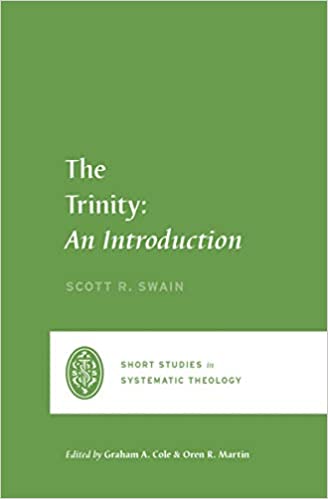A Brief Book Notice from Books At a Glance
Fred G. Zaspel
If this new book is any indication, Crossway’s new Short Studies in Systematic Theology series (Graham Cole & Oren Martin, eds.) is destined to be a smashing success. In about 120 rather small pages Scott Swain provides what is now almost certainly the best introduction to the doctrine of the Trinity available. “Introduction,” yes, for there are depths still to be explored, further than a “Short Study” can take us, but this little book is remarkable for its concise yet comprehensive exposition of the major themes essential to trinitarian theology. A genuinely welcome contribution to this growing field of study.
Table of Contents
1 The Bible and the Trinity: The Basic Grammar
2 The Bible and the Trinity: Three Types of Texts
3 The Simplicity of God
4 God the Father
5 God the Son
6 God the Holy Spirit
7 The Shape of God’s Triune Work
8 The End of God’s Triune Work
Swain’s approach is refreshingly exegetical yet well-informed by the classical formulations of the doctrine that the church has inherited. Though many of the concepts themselves inevitably leave us in over our heads, Swain’s treatment is eminently accessible.
In this book, our main focus is on the scriptural patterns of naming the triune God and the way those patterns have been received and confessed by the church in response to the triune God’s self-revelation in Holy Scripture…. The Bible is the primary discourse of Trinitarian theology…. [T]he primary task of Trinitarian theology is to gain fluency in the Bible’s primary Trinitarian discourse (pp.18, 26, 27).
That is to say, our formulation of the doctrine must commence from and conform to the ways in which the inspired writers present it. Swain insightfully summarizes this biblical data in chapters 1 and 2. “The Bible’s basic Trinitarian grammar affirms the oneness of God, identifies the three persons of the Trinity with the one God, and distinguishes the three persons of the Trinity by their relations of origin” (p. 59). With these primary thought-structures of Scripture in mind his theological formulations follow with ease and with definitive clarity.
Swain next helpfully grounds trinitarian thinking within the framework of divine simplicity (ch. 3) and then leads us to consider, in turn, the Father, the Son, and the Spirit (chs. 4-6). As is true of the book entirely these chapters are marked by both theological precision and cheerful doxology. Chapters 7-8 conclude with an examination of “The Shape of God’s Triune Work” and “The End of God’s Triune Work” respectively.
It will be of interest to many readers to note that Swain does address the recent debate concerning “eternal functional subordination” (EFS) or “Eternal Relations of Authority and Submission” (ERAS), the controversy that erupted a few years ago. His assessment (thankfully) lacks the offensive tone that marked too much of the discussion then, but he nonetheless offers frank evaluation:
EFS affirms the eternal distinction of the persons of the Trinity, and though it affirms their full deity, both affirmations are compromised by the significant revisions it makes to classical Christian teaching on the Trinity. Rather than distinguishing the persons of the Trinity by means of relations of origin (i.e., paternity, filiation, and spiration), ERAS distinguishes the persons by means of relations of authority and submission…. This revision to classical Christian teaching regarding the personal properties of the Trinity brings with it further revisions to classical Christian teaching regarding the nature of God. Rather than recognizing divine authority and divine willing as common properties of the three persons, ERAS treats these attributes as personal properties, dividing them among the three persons. The Father has an authority in relation to the Son that the Son lacks, and so forth…. ERAS has been the source of not a little controversy among Reformed and evangelical Christians in recent years, and not without reason. Although a spectrum of views falls under the heading of ERAS, reflecting varying degrees of error and impiety, many of its most basic tenets are quite problematic, and its most extreme expression exhibits a number of grave theological errors. Classical Christian teaching on the Trinity set important boundary lines in distinguishing the divine persons by means of relations of origin and in preserving their divine oneness by means of divine simplicity. Because these boundary lines accord with the canons of biblical reasoning, they cannot be transgressed without serious consequences.
If you are at all unfamiliar with the various nuances at issue in that famous controversy, Swain’s new book will set you well along the way in short shrift.
Highest marks. Highest recommendation. This book is now the place to start.
